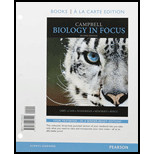
To explain:
Why eating “hot” peppers cause a person to sweat.
Introduction:
The detection of stimulus with the help sensory cells is known as sensory reception. The sensory receptors is of two type generally, either they detect the stimuli from outside environment or they respond to the internal body stimuli and the activation of sensory receptor does not require large amount of energy for the stimulation. Thermo receptors are non specialized receptors that sense the change in the temperature for example certain snakes recognize the prey through thermo receptors which detects infrared radiation emitted by the body of warm prey.
Want to see the full answer?
Check out a sample textbook solution
Chapter 38 Solutions
Campbell Biology in Focus, Books a la Carte Edition; Modified Mastering Biology with Pearson eText - ValuePack Access Card - for Campbell Biology in Focus (2nd Edition)
- 12. Which of the following molecules can absorb light? a. Pigments b. Chlorophyll c. Rhodopsin d. Carotenoids e. All of the abovearrow_forwardWhich of the following proteins or protein complexes is directly required for the targeting of mitochondrial inner membrane multipass proteins, such as metabolite transporters, whose signal sequence is normally not cleaved after import? OA. TIM22 OB. TIM23 C. OXA OD. Mia40 OE SAMarrow_forwardQUESTION 9 An animal cell has been wounded and has a small rupture in its plasma membrane. Which of the following is more likely to happen next? OA. The cell rapidly cleaves by cytokinesis. OB. The rate of receptor-mediati endocytosis is increased. OC. The rate of exocytosis is increased. OD. The rate of pinocytosis is increased.arrow_forward
- For the a subunit of a trimeric G protein, A. a G-protein-coupled receptor GPCR) acts as a guanine nucleotide exchange factor (GEF), whereas a regulator of G protein signaling (RGS) can act as a GTPase-activating protein (GAP). B. a GPCR acts as a GAP, whereas an RGS can act as a GEF. C. both a GPCR and an RGS can act as a GEF. O D. both a GPCR and an RGS can act as a GAP OE. None of the above.arrow_forwardA cell expresses a transmembrane protein that is cleaved at the plasma membrane to release an extracellular fragment. The fragment binds to receptor proteins on nearby cells and activates signaling pathways resulting in altered gene expression patterns in the cells. What form of intercellular signaling does this represent? OA. Contact-dependent signaling B. Paracrine signaling OC. Synaptic signaling D. Endocrine signaling E. Autocrine signalingarrow_forwardWhich of the following drive nuclearly encoded proteins import into the mitochondrial matrix? OA. ATP hydrolysis OB. Membrane Potential OC. K+ Ions OD. A and B OE. None of the abovearrow_forward
- Which of the following statements is true regarding Cholesterol import into the cell? OA. It is transported within LDL B. Receptor mediated endocytosis is involved OC. Release of cholesterol occurs in the Lysosome D. All of the above are true statements OE. None of the above are true statementsarrow_forwardIn which of the following schematic drawings of signaling pathways does the activation of the receptor lead to gene expression? Activating and inhibitory steps are indicated with (+) and (-), respectively. OA OB ㅇㅂㅇㅂㅇㅁ (+) Gene Expression Activated Signaling proteins Transcription receptor activator Bl D Gene Expression Gene Expression ㅁㅁㅇ Gene Expression Gene Expressionarrow_forwardWhich of the following events normally activates a GTP-binding protein? OA. GTP hydrolysis by the protein OB. Activation of an upstream GTPase-activating protein OC. Activation of an upstream guanine nucleotide exchange factor OD. Phosphorylation of a bound GDP molecule by an upstream phosphorylase OE. Pi release after GTP hydrolysisarrow_forward
- Proteins that are synthesized on the Rough ER are imported into the ER lumen after their signal sequence is recognized. Which of the following is responsible for the signal recognition? OA. Signal Recognition Particle, OB. Signal Sequence C. Stop-transfer sequence OD. Both B and C OE. None of the abovearrow_forwardStroma Light 4 H 4 H I Thylakoid- membran 2 H₂O D1 D2 Min Light 2,6 ATP 2 NADP+ 2 NADPH/H+ Fp 2,6 ADP +2,6 P 8 H+ 12 H+ 4 H+ Lumen PS II Cyt bef PS I ATP-Synthase 12345 5a 5b 6arrow_forwardWhich of the following statements is TRUE regarding the signal recognition particle (SRP)? OA. SRP is made up of RNA and Proteins B. SRP binds to the signal sequence OC. SRP binds to the elongation factor binding site on the ribosome and pauses translation D. All of the above are true statements OE. None of the above are true statementsarrow_forward
 Anatomy & PhysiologyBiologyISBN:9781938168130Author:Kelly A. Young, James A. Wise, Peter DeSaix, Dean H. Kruse, Brandon Poe, Eddie Johnson, Jody E. Johnson, Oksana Korol, J. Gordon Betts, Mark WomblePublisher:OpenStax College
Anatomy & PhysiologyBiologyISBN:9781938168130Author:Kelly A. Young, James A. Wise, Peter DeSaix, Dean H. Kruse, Brandon Poe, Eddie Johnson, Jody E. Johnson, Oksana Korol, J. Gordon Betts, Mark WomblePublisher:OpenStax College
 Nutrition Through The Life CycleHealth & NutritionISBN:9781337919333Author:Brown, Judith E.Publisher:Cengage Learning,
Nutrition Through The Life CycleHealth & NutritionISBN:9781337919333Author:Brown, Judith E.Publisher:Cengage Learning, Comprehensive Medical Assisting: Administrative a...NursingISBN:9781305964792Author:Wilburta Q. Lindh, Carol D. Tamparo, Barbara M. Dahl, Julie Morris, Cindy CorreaPublisher:Cengage Learning
Comprehensive Medical Assisting: Administrative a...NursingISBN:9781305964792Author:Wilburta Q. Lindh, Carol D. Tamparo, Barbara M. Dahl, Julie Morris, Cindy CorreaPublisher:Cengage Learning





